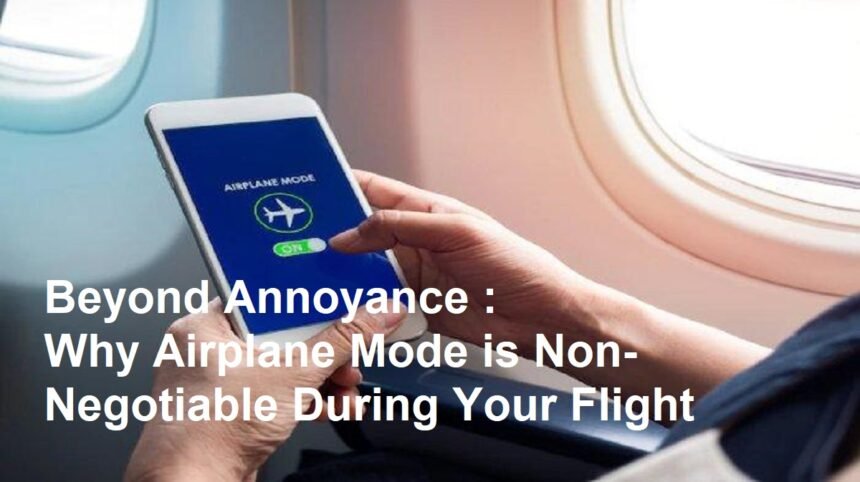Introduction
That familiar announcement echoes through the cabin: “Please ensure all electronic devices are switched to airplane mode or turned off.” For many passengers, it’s a minor inconvenience, a pause in scrolling or streaming often met with a quick tap or begrudging compliance. But why is this seemingly simple instruction so critical? The reasons extend far beyond mere annoyance, touching the core of aviation safety, technical realities, and practical network management.
1. The Core Safety Concern: Preventing Potential Interference
The primary reason for airplane mode is mitigating the risk of electromagnetic interference (EMI) with critical aircraft systems. Modern aircraft rely on a complex network of sensitive electronics for navigation, communication, and flight control. These systems operate on specific radio frequencies.
- How Devices Emit Signals:Your smartphone, tablet, or e-reader constantly emits radio frequency signals when not in airplane mode. This happens when it’s searching for a cellular network (even if you’re not actively making a call), connecting to Bluetooth, or using Wi-Fi. These signals are relatively weak individually.
- The Cumulative Risk:Imagine hundreds of devices in a large aircraft simultaneously emitting signals across various frequencies. While the risk of a single device causing catastrophic failure is considered extremely low by many experts, the cumulative effect of many devices is harder to predict and quantify definitively.
- Protecting Critical Frequencies:The most crucial concern lies with frequencies used for:
- Navigation:Systems like VOR (VHF Omnidirectional Range), ILS (Instrument Landing System), and GPS are vital for knowing the aircraft’s position, especially in poor visibility or during critical phases like landing.
- Communication:Clear radio communication between the cockpit and air traffic control is essential for situational awareness and safety instructions.
- Altitude and Speed Measurement:Radiosondes and other instruments providing critical flight data.
While modern aircraft are designed with significant shielding and robustness against interference, and incidents directly linked to personal electronic devices (PEDs) are exceptionally rare (often anecdotal or unconfirmed), the aviation industry operates on the precautionary principle. Why take even a minuscule, avoidable risk when passenger safety is paramount? Switching to airplane mode completely halts these potentially disruptive transmissions, eliminating the variable.
2. Avoiding Network Chaos on the Ground
Beyond aircraft systems, there’s a significant practical reason related to terrestrial cellular networks:
- The “Roaming Tower” Problem:As a plane flies at high speed and altitude, your phone, if left searching for a signal, will attempt to connect to multiple ground-based cell towers in rapid succession.
- Network Strain:Each connection attempt requires network resources. With hundreds of phones on a single flight doing this simultaneously as it passes over populated areas, it can create unnecessary strain and potential interference for ground networks. This “roaming” at high speed isn’t how cellular networks are designed to operate efficiently.
- Battery Drain:Frantically searching for a non-existent or constantly changing signal is one of the biggest drains on your device’s battery. Airplane mode prevents this wasteful energy consumption, ensuring your device has power when you land.
3. Why Takeoff and Landing Are Especially Crucial
While airplane mode is required throughout the flight, flight crews often emphasize switching devices off or to airplane mode specifically during takeoff and landing. These are the most critical phases of flight:
- Heightened Focus:Pilots and crew need absolute focus during these complex maneuvers with minimal margin for error. Any potential distraction or system anomaly, however unlikely, is best avoided.
- Uninterrupted Communication:Clear communication between the cockpit, cabin crew, and air traffic control is vital. Minimizing any potential source of signal noise is essential.
- Rapid Evacuation Readiness:Having devices stowed or secured prevents them from becoming hazardous projectiles in the extremely unlikely event of a sudden impact or emergency evacuation.
4. The Wi-Fi and Bluetooth Exception (When Allowed)
Airplane mode typically disables cellular, Wi-Fi, and Bluetooth. However, once the aircraft reaches cruising altitude and if the airline offers onboard Wi-Fi, you are usually permitted to re-enable Wi-Fi and Bluetooth specifically. Why is this safe?
- Controlled Environment:The aircraft’s onboard Wi-Fi system operates on frequencies specifically chosen and certified not to interfere with critical avionics. It acts as a controlled access point.
- Bluetooth Range:Bluetooth signals are very short-range (typically under 10 meters), posing negligible risk to aircraft systems when used for headphones or keyboards within your seat area.
- Crew Authorization:Crucially, you should only enable Wi-Fi/Bluetooth after the crew explicitly announces it is permitted. They operate based on the specific phase of flight and system status.
Conclusion
Using airplane mode isn’t just about following an arbitrary rule; it’s a fundamental aspect of modern aviation safety protocol grounded in risk mitigation. While the likelihood of personal electronics causing an incident is very small, the potential consequences are immense. Eliminating even theoretical sources of interference is a cornerstone of the aviation industry’s unparalleled safety record. Combined with the benefits of preventing network congestion and saving your battery, switching to airplane mode is a small, effortless action that contributes significantly to the safety and smooth operation of every flight. It’s a shared responsibility – a simple tap that helps ensure everyone arrives safely at their destination. Always listen to the crew’s instructions; they are there for your safety.












